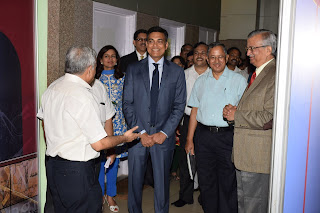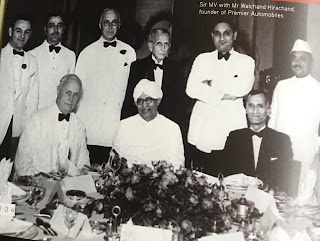Homage to Sir M Visvesvaraya: The Legendary Nation Builder
14th April has an extraordinary significance with Indian history. It is inextricably linked to two of the nation builders of modern India - Dr Bhimrao Ambedkar and Sir Mukshagundam Visvesvaraya (Sir MV) - who have been deservingly conferred with the Bharat Ratna Award. It was on this day in 1891 that father of our Indian Constitution, Dr Bhimrao Ambedkar was born in the cantonment in Mhow, Central Province, now in Madhya Pradesh. On this very day in 1962, the legendary nation builder Engineer, Sir Mokshagundam Visvesvaraya, on whose birthday 15th September, the whole nation celebrates as ‘ Engineers Day’, breathed his last in Bangalore.
I was privileged to have had the honour to be the Director of the Visvesvaraya Industrial and Technological Museum, Bangalore during the fiftieth anniversary (2012) of the Punya Thithi ( death anniversary) of Sir MV. After a stint of nearly four years as the Director of the National Science Centre in Delhi, I was fortuitously transferred to Bangalore, my home state in 2011. The Visvesvaraya Museum was established in honour of the legend and it was the result of a decision taken by the then Honourable Prime Minister, Pandit Nehru, who declared setting up a museum in honour of Sir MV. Nehru ji made this announcement during the centennial birthday celebrations of Sir MV at the historic and pristine Lalbagh grounds where the celebrations was organised, which was attended by Sir MV himself. Sir MVs contribution to the state of Karnataka has been immortalised in an epic Kannada film titled ‘Bangarada Manushya’, where the legend of Kannada films Dr Rajkumar eulogises Sir MV in an immemorable song. Being an engineer and that too from Karnataka, we all grew up idolising Sir M Visvesvaraya and my posting in Bangalore provided me an opportunity to pay our respect and homage to Sir MV during the fiftieth year of his death anniversary in 2012. I had the honour to curate a very well researched exhibition, which was opened at the Visvesvaraya Museum in Bangalore. I was ally supported by Ms Jyoti Mehra.
Just as I was lucky in getting a transfer to Bangalore from Delhi, I was equally unlucky to get transferred from Bangalore to Mumbai in just about two years time. The Sir MV exhibition, which we had created at Visvesvaraya Museum Bangalore came in handy during the 102nd India Science Congress, which was held in Mumbai from Jan 3-7 in 2015. Dr Anil Kakodkar who was the Chairman of a committee asked me to,present this exhibition at the Hall of Pride pavilion. He was privy to the exhibition since we had managed to obtain corporate funding for publishing a richly illustrated exhibition catalog, which supplemented the exhibition. Sir MV exhibition at NSC Mumbai was opened by Mr Sajjan Jindal and Mrs Sangeeta Jindal in the August presence of Dr Anil Kakodkar. Due to shortage of time and so also money we were unable to publish the book in Bangalore, which I could do in Mumbai courtesy benevolent funding from JSW. ‘Sir M V : The Legendary Nation Builder’, exhibition and the richly illustrated exhibition catalog were an outcome which drew on a range of research, sources, books, journals, images, documentary, visuals and audio, that collectively helped us in highlighting the unique contributions of Sir M Visvesvaraya in nation building.
Some of the rare archival information and photographs can be seen in the exhibition and so also in the book, which include the will of Sir MV, his engineering degree certificate, his passport, several of his writings etc.
In the annals of human history very few people have had the dispensation of celebrating their own birth centenary; from amongst those few who have, there are no parallels to the life that Sir M Visvesvaraya lived for all of 102 years. Visvesvaraya, popularly referred to as Sir MV, was an engineer par excellence, statesman, visionary, a staunch votary of industrialization, education and women empowerment, banking, father of planned economy, transportation and innumerable other contributor. He strenuously worked for eight long decades for building our nation. There are very few fields of thoughts and constructive endeavours, of technical advancement and nation building in which Sir MV had not made a significant contribution. Some of his contributions include engineering, in all its branches, particularly those of irrigation, reservoirs, dams and water supply, power supply and bridge building; university education, technological and occupational training, town planning, industry and banking, commerce and manufacture. Sir MV was a man with impeccable integrity, discipline and a grand visionary for the nation. Krishnarajasagara (KRS), one of the premier reservoirs of the country, owes its existence to him. His contributions at the Khadakwasla (Pune) water reservoir, where he introduced the automatic sluice water gates, won him a patent, which he did not use for his personal benefit. This very design, he subsequently used in the world famous Krishna Raja Sagara Dam (KRS).
KRS alone, one of the largest of its kind in the world, would perpetuate
the name of Sir MV. Pandit Nehru, the architect of modern India, borrowed the idea of planned economy from Sir MV. From Aden to Pune, Sukkur, Nashik, Hyderabad, Mysore, and several other cities and projects, Sir MV's civil engineering contributions are spread across the country and abroad. His engineering services were used in various capacities all across the country including in building the Hirakud Dam, in Odisha, a Railway Bridge across Ganga in Patna, combating floods in Hyderabad, constructing the Himayatsagar and the Osmansagar reservoirs across the rivers Musi and Easi, and in the reconstruction of Hyderabad city and preparation of the drainage scheme for the city. Sir MV was also a member of the engineering committee that was involved in construction of several buildings in Lutyens Delhi.
Sir MV, the man with an impeccable integrity far beyond one can imagine, was known for his foresight and prophetic vision for industrial development, which he advocated was essential for alleviating poverty. He was a master in irrigation designs and was very passionate about effective utilization of scarce water resource for drinking and irrigation purpose. Block System of Irrigation, Automatic Sluice gates and Collector Well are some important innovations of Sir MV. Automatic Sluice gates, used in Pune and in KRS and other dams, enable storage of water well above the crest of the weir of the Dam. He designed the Block system of Irrigation to optimize, control and evenly distribute water supply to parched agricultural lands across number of villages. The supply was rotated within “blocks” in each village to curtail misuse and water logging. This system, devised in 1899, continues to be used even today in Deccan Canals. The collector wells can provide moderate to large quantities of naturally filtered water from the river beds.
Sir MV was a firm believer that development alone can bring about prosperity for people. He also believed that India could be benefited from harvesting the knowledge and experience of the prosperous nations. Visvesvaraya toured many developed countries of the world to study, understand and evaluate the success of their prosperity and for replicating the same in India. During his six foreign travels, he visited Japan, America, Canada and many European countries. An outcome of his learning from foreign visits is embodied in the establishment of several industries and educational institutes in the state of Karnataka.
Visvesvaraya served his mother state Mysore (now Karnataka) in different capacities, first as the Chief Engineer to the government in 1909 and next as the Dewan of Mysore from 1912 to 1918. He firmly believe that education is fundamental to the progress of the nation.
His regime as the Dewan of Mysore witnessed unprecedented growth in the establishment of a number of primary schools. In just six years of his tenure as the Dewan an additional 6,500 new schools were added. He pronounced a revolutionary legislation making primary education compulsory for every child, including the girl child. He also believed in social upliftment of the depressed communities and backward classes and laid special emphasis on education of girls. He was instrumental in establishing educational institutes, industries, banks, Mysore University and Agriculture Science College. He also used his personal money to help establish a vocational college (Jayachamarajendra Polytechnic College). HAL the premier aircraft manufacturing company in Bangalore, the steel, sugar and soap factories in Karnataka owe their existence to Sir MV. The Premier Automobile Company in Pune, which was the first automobile company in India, owes its genesis to Sir MV. He improved the Railway infrastructure of Mysore and established clubs and association for improvement of the state. He was associated with the premier Indian Institute of Science and promoted linkage of industries with scientific institutes.
Sir MV received the knighthood from the British Empire. He received the
Bharat Ratna in the year 1955. After actively serving the nation for more than 100 years Sir MV breathed his last on 14th April, 1962 at Bangalore. On the eve of the centenary celebrations of Sir MV, which was held at Bangalore in 1960, Jawaharlal Nehru, the then Prime Minister of India, who had joined the centenary celebration to honour Sir MV, announced a befitting tribute to Sir MV for establishing a Industrial and technological Museum to be named after Sir MV. Thus was established the Visvesvaraya Industrial and Technological Museum (VITM) at Bangalore, the foundation for which was also laid by Pt. Nehru.
Fifty eight years have passed since the passing away of Sir MV but then he continues to remain in the hearts and minds of the people of zinda particularly the Engineers who look up to him as a true role model, par excellence. Long live Sir MV.
For those of you who may be interested in reading the book you may please down load it from our website under the Publications sections, where you will find all our publications which are free for download.
www.nehrusciencecentre.gov.in






























No comments:
Post a Comment